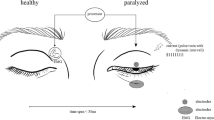Summary
Transcorneal potential difference (PD) and short circuit current (SCC) measurement were performed on isolated human, Rhesus monkey and rabbit cornea preparations. In the isolated human and monkey corneas a mean transcorneal PD of 1–3 mV and a mean SCC of 2–4 μA · cm−2 exists. Both values were small but within the same range as data obtained in other isolated cornea preparations. PD and SCC were found to be pH sensitive in all three species. When the bathing solutions were kept at a pH 7.6 polarity of human, monkey and rabbit cornea was endothelium positive with respect to epithelium. In human cornea PDmax was 11.5 mV and SCCmax 5.1 μA · cm−2. At pH 8.6 (bicarbonate Ringers solution + air polarity of human and monkey cornea was endothelium negative. In the rabbit cornea the endothelium was still positive, even more positive than at pH 7.6. In human cornea at pH 8.6 PDmax slightly decreased and SCCmax increased.
Similar content being viewed by others
References
Adler, F. H.: Physiology of the eye. 4th edit. St. Louis: C. V. Mosby 1965
Akaike, Naio, Hovi, M.: Effect of anions and cations on membrane potential of rabbit corneal epithelium. Amer. J. Physiol.219, 1811–1818 (1970)
Candia, O. H.: Effect of pH on chloride transport across the isolated bull frog cornea. Exp. Eye Res.15, 375–382 (1973)
Dikstein, S., Maurice, D. M.: The metabolic basis to the fluid pump in the cornea. J. Physiol. (Lond.)221, 29–41 (1972)
Dobson, J. G., Kidder, G. W.: Edge damage effect in vitro frog skin preparations. Amer. J. Physiol.214, 719–724 (1968)
Documenta Geigy: Wissenschaftliche Tabellen. J. R. Geigy A. G., Pharma, Basel, 7. Aufl. 1968
Donn, A., Maurice, D. M., Mills, N. L.: Studies on the living cornea in vitro. I. Method and physiologic measurements. Arch. Ophthal.62, 741–747 (1959a)
Donn, A., Maurice, D. M., Mills, N. L.: The active transport of sodium across the epithelium. Arch. Ophthal.62, 748–757 (1959b)
Ehlers, N.: In vitro studies of trans- and intraepithelial potentials of the cornea. Exp. Eye Res.15, 553–565 (1973)
Ehlers, N., Ehlers, D.: Effect of hydrostatic and colloid-osmotic pressure on electrical potential and short-circuit current across the explanted rabbit cornea. Acta Ophthal.46, 767–778 (1968)
Fischer, F., Voigt, G., Liegl, O., Wiederholt, M.: Potential difference and short circuit current in isolated human cornea. Pflügers Arch.332, Suppl., R 91 (1972)
Friedman, M. H.: Unsteady aspects of corneal thickness control. Exp. Eye Res.15, 645–658 (1973)
Green, K.: Ion transport in isolated cornea of the rabbit. Amer. J. Physiol.209, 1311–1316 (1965)
Green, K.: Dependence of corneal thickness in epithelial ion transport and stromal sodium. Amer. J. Physiol.217, 1169–1177 (1969)
Helman, S. I., Miller, D. A.: Edge damage effect on electrical measurements of frog skin. Amer. J. Physiol.225, 972–977 (1973)
Lichey, H.-J., Fischer, F., Wiederholt, M.: Intracellular potentials in the isolated human cornea. Pflügers Arch.346, 351–360 (1974)
Lindemann, B.: Resting potential of isolated beef cornea. Exp. Eye Res.7, 62–69 (1968)
Maurice, D. M.: The location of the fluid pump in the cornea. J. Physiol. (Lond.)221, 43–54 (1972)
Modrell, R. W., Potts, A. M.: The influence of medium composition, pH and the temperature on the transcorneal potential. Amer. J. Ophthal.48, 834–842 (1959)
Müller-Limmroth, W.: Gesichtssinn. In: Landois-Roseman: Lehrbuch der Physiologie des Menschen. 28th edit. München-Berlin: Urban & Schwarzenberg 1962
Potts, A. M., Modrell, R. W.: The transcorneal potential. Amer. J. Ophthal.44, 284–290 (1957)
Riley, M. V.: The role of the epithelium in control of corneal hydration. Exp. Eye Res.12, 128–137 (1971)
Shapiro, M. P., Candia, O. A.: Corneal hydration and metabolically dependent transcellular passive transfer of water. Exp. Eye. Res.15, 659–666 (1973)
Ussing, H. H., Zerahn, K.: Active transport of sodium as the source of electric current in the short-circuited isolated frog skin. Acta physiol. scand.23, 110–127 (1951)
Walser, M.: Role of edge damage in sodium permeability of toad bladder and means of avoiding it. Amer. J. Physiol.219, 252–255 (1970)
Zadunaisky, J. A.: Active transport of chloride in frog cornea. Amer. J. Physiol.211, 506–512 (1966)
Zadunaisky, J. A.: Electrophysiology and transparency of the cornea. In: Electrophysiology of epithelial cells. G. Giebisch, Ed. Stuttgart-New York: F. K. Schattauer 1971
Zadunaisky, J. A., Lande, M. A.: Active chloride transport and control of corneal transparency. Amer. J. Physiol.221, 1837–1844 (1971)
Author information
Authors and Affiliations
Additional information
Supported by Deutsche Forschungsgemeinschaft
Rights and permissions
About this article
Cite this article
Fischer, F., Voigt, G., Liegl, O. et al. Effect of pH on potential difference and short circuit current in the isolated human cornea. Pflugers Arch. 349, 119–131 (1974). https://doi.org/10.1007/BF00586623
Received:
Issue Date:
DOI: https://doi.org/10.1007/BF00586623




